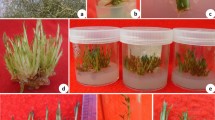Abstract
Picea glauca (white spruce) zygotic embryos and one-week-old-seedling epicotyl explants were placed on either Woody Plant Medium (WPM) or half-strength Schenk & Hildebrandt (1/2S&H) medium supplemented with varying levels of benzyladenine (BA) (0.1, 1.0, 10, 50, 100 μM), zeatin (10, 50, 100 μM) or thidiazuron (TDZ) (0.01, 0.1 μM). In addition to differences in the number of buds induced at three months on the two media, buds induced on WPM were visually more uniform, less vitrified and elongated faster. On 1/2S&H supplemented with BA, maximum bud induction from embryos occurred on 1.0 μM BA with 0.01 μM TDZ with higher BA concentrations inhibitory to bud induction. In contrast, on WPM there was little difference in the number of buds induced from embryos placed on 10, 50 and 100 μM BA with or without TDZ. One-week-old-seedling epicotyl explants required higher BA levels on 1/2S&H, as bud induction at three months was greatest at 10 μM BA. On WPM, as with the embryos, there were only minor differences in the number of buds induced from epicotyl explants on the various BA levels. Zeatin was more effective at inducing buds than BA with both media. From embryos, bud induction was greatest on 50 or 100 μM zeatin without TDZ and 50 or 100 μM zeatin with or without TDZ on 1/2S&H and WPM respectively. From epicotyl explants on 1/2S&H, there was little difference in the number of buds induced with the zeatin concentrations used, while with WPM, 50 and 100 μM zeatin induced the greatest number of buds. Interestingly, with BA, the epicotyl explants needed a higher level than the embryos for maximal response, while with zeatin, the level was the same for both embryos and epicotyl explants. Long-term (six month) survival was higher on WPM than with 1/2S&H. Additionally, embryos had a higher percentage of genotypes surviving at six-months when compared with epicotyl explants. For overall survival and development of the buds, 50 μM zeatin with 0.01 μM TDZ was the best treatment tested.
Similar content being viewed by others
Abbreviations
- BA:
-
benzyladenine, 1/2S&H-half-strength Schenk & Hildebrandt medium
- TDZ:
-
thidiazuron
- WPM:
-
woody plant medium
References
DavidA (1982) In vitro propagation of gymnosperms. In: BongaJ & DurzanD (Eds) Tissue Culture in Forestry (pp 72–108). Dr. Junk, The Hague
EllisDD & BilderbackDE (1989) Temporal competence of embryonic Pinus ponderosa cotyledons to form multiple buds in vitro. Amer. J. Bot. 76: 348–355
FiolaJA, HassanMA, SwartzHJ, BorsRH & McNicolsR (1990) Effect of thidiazuron, light fluence rates and kanamycin on in vitro shoot organogenesis from excised Rubus cotyledons and leaves. Plant Cell Tiss. Org. Cult. 20: 223–228
FlinnBS, WebbDT & GeorgisW (1989) In vitro control of caulogenesis by growth regulators and media components in embryonic explants of eastern white pine. Can. J. Bot. 64: 1948–1996
LloydG & McCownB (1980) Commercially feasible micropropagation of mountain laurel Kalmia latifolia by use of shoot tip culture. Inter. Plant Prop Combined Proc. 30: 421–426
RumaryC & ThorpeTA (1984) Plantlet formation in black and white spruce, I. In vitro techniques, Can. J. For. Res. 14: 10–16
SchenkRU & HildebrandtAC (1972) Medium and techniques for induction and growth of monocotyledonous and dicotyledonous plant cell cultures. Can. J. Bot. 50: 199–204
ToivonenPMA & KarthaKK (1988) Regeneration of plant-lets from in vitro cultured cotyledons of white spruce (Picea glauca (Moech) Voss). Plant Cell Rep. 7: 318–321
vonArnoldS & ErikssonT (1986) Norway spruce (Picea abies). In: BajajYPS (Ed) Biotechnology in Agriculture and Forestry, Vol 1 (pp 291–310). Trees I. Springer-Verlag, Berlin
Author information
Authors and Affiliations
Rights and permissions
About this article
Cite this article
Ellis, D.D., Barczynska, H., McCown, B.H. et al. A comparison of BA, zeatin and thidiazuron for adventitious bud formation from Picea glauca embryos and epicotyl explants. Plant Cell Tiss Organ Cult 27, 281–287 (1991). https://doi.org/10.1007/BF00157592
Received:
Accepted:
Issue Date:
DOI: https://doi.org/10.1007/BF00157592




